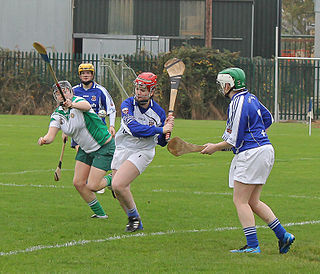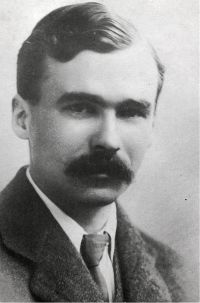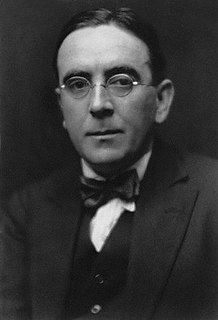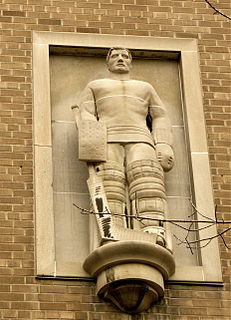Related Research Articles

Ice hockey is a contact team sport played on ice, usually in an indoor or outdoor rink, in which two teams of skaters use their sticks to shoot a vulcanized rubber puck into their opponent's net to score goals. The sport is known to be fast-paced and physical, with teams usually fielding six players at a time: one goaltender to stop the puck from going into their own net, two defensemen, and three forwards who skate the span of the ice trying to control the puck and score goals against the opposing team.

In Greek mythology, Narcissus was a hunter from Thespiae in Boeotia who was known for his beauty. According to Tzetzes, he rejected all romantic advances, eventually falling in love with his own reflection in a pool of water. He later died, and in his place sprouted a flower bearing his name.

Camogie is an Irish stick-and-ball team sport played by women. Camogie is played by 100,000 women in Ireland and worldwide, largely among Irish communities.

Michael Laurence Nyman, CBE is an English composer of minimalist music, pianist, librettist and musicologist, known for numerous film scores, and his multi-platinum soundtrack album to Jane Campion's The Piano. He has written a number of operas, including The Man Who Mistook His Wife for a Hat; Letters, Riddles and Writs; Noises, Sounds & Sweet Airs; Facing Goya; Man and Boy: Dada; Love Counts; and Sparkie: Cage and Beyond. He has written six concerti, five string quartets, and many other chamber works, many for his Michael Nyman Band. He is also a performing pianist. Nyman prefers to write opera over other forms of music.

George Sainton Kaye Butterworth, MC was an English composer who was best known for the orchestral idyll The Banks of Green Willow and his song settings of A. E. Housman's poems from A Shropshire Lad.

John Nicholson Ireland was an English composer and teacher of music. The majority of his output consists of piano miniatures and of songs with piano. His best-known works include the short instrumental or orchestral work "The Holy Boy", a setting of the poem "Sea-Fever" by John Masefield, a formerly much-played Piano Concerto, the hymn tune Love Unknown and the choral motet "Greater Love Hath No Man".

In ice hockey, the goaltender or goalie is the player responsible for preventing the hockey puck from entering their team's net, thus preventing the opposing team from scoring. The goaltender usually plays in or near the area in front of the net called the goal crease. Goaltenders tend to stay at or beyond the top of the crease to cut down on the angle of shots. In today's age of goaltending there are two common styles, butterfly and hybrid. Because of the power of shots, the goaltender wears special equipment designed to protect the body from direct impact. The goalie is one of the most valuable players on the ice, as their performance can greatly change the outcome or score of the game. One-on-one situations, such as breakaways and shootouts, have the tendency to highlight a goaltender's pure skill, or lack thereof. No more than one goaltender is allowed to be on the ice for each team at any given time. Teams are not required to use a goaltender and may instead opt to play with an additional skater, but the defensive disadvantage this poses generally means that the strategy is only used as a desperation maneuver when trailing late in a game or can be used if the opposing team has a delayed penalty.
Green Ways is a set of three short atmospheric piano works composed by John Ireland in 1937; the individual titles are The Cherry Tree, Cypress and The Palm and May. They were written when the composer was 57, and are among the last pieces he wrote for piano.
The Voice of the People is an anthology of folk songs produced by Topic Records containing recordings of traditional singers and musicians from England, Ireland, Scotland and Wales.
Two Pieces for Piano is a work for piano solo composed in 1921 by John Ireland (1879–1962).
Rhoda Sinclair Coghill was an Irish pianist, composer and poet.
The Land of Lost Content is a song cycle for voice and piano composed in 1920–21 by John Ireland (1879–1962). It consists of settings of six poems by A. E. Housman from his 1896 collection A Shropshire Lad.
Preludes for Piano is a set of four short pieces for piano solo composed by John Ireland between 1913 and 1915. They were published in the latter year.
Two Pieces for Piano is a set of two pieces for piano solo composed in 1925 by John Ireland.
Two Pieces for Piano is a work for piano solo composed in 1929–30 by John Ireland.
Decorations is a set of three pieces for piano solo composed in 1912–13 by John Ireland.
Leaves from a Child's Sketchbook is a set of three pieces for piano solo composed in 1918 by John Ireland.
London Pieces is a set of three pieces for piano solo composed in 1917–20 by John Ireland.
Sarnia: An Island Sequence is a set of three pieces for piano solo composed in 1940–41 by John Ireland.
References
- ↑ "List of works – T to Y". The John Ireland Trust. Retrieved 2 May 2015.
- ↑ John Ireland: Pastels (3), for piano at AllMusic . Retrieved 2 May 2015.
- ↑ 2 Piano Pieces (Ireland, John) : Scores at the International Music Score Library Project
| | This article about a classical composition is a stub. You can help Wikipedia by expanding it. |